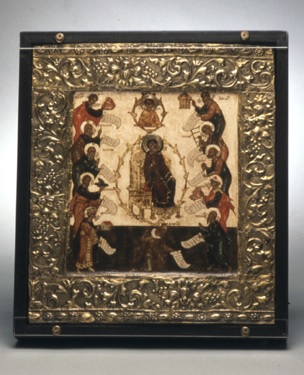
Unknown
Russian
Praises to the Mother of God, 1550-1600 ca.
egg tempera on wood, silver revetment
12 x 10 5/8 in.
SBMA, Anonymous Gift
1961.5.5
COMMENTS
Description
The enthroned Virgin Mary as the Mother of God occupies the central position in this formal composition. Above her appears a bust of Christ Emmanuel blessing the Virgin and holding a scroll. Both of these figures have attached silver halos. The figure crouching below the Virgin’s footstool is the Old Testament prophet Balaam holding a scroll. Ten other Old Testament prophets, all holding scrolls and turned towards the Virgin, are arranged symmetrically on the sides.
Origin, Iconography and Style
A special veneration called “hyperdulia” developed for Mary, the Mother of God. She was exalted above all the saints and celestial hierarches. As the humble handmaiden of the Lord, she was found to be spotless and pure. Thus, she was chosen as the worthy mother of the Son of God. She above all is man’s hope for the forgiveness of sins, since she has the most influence as intercessor before the throne of the Eternal Judge.
Wearing a deep red Maphorion, the Virgin Mary is enthroned; her right hand is raised with palm out and her left hand rests on her knee. She bows her head in humility. A figure-eight floral wreath surrounds her and extend upward to enframe the youthful Christ Emmanuel. The eleven Old Testament prophets, some of which hold attributes, are arranged in the following order:
Habbakuk holding a mountain
Jeremiah
Isaiah
Moses holding a bush
Kind David with the synagogue
Balaam with star
Ezekiel with Royal Door
Jacob holding ladder
Gideon holding fleece
Daniel with a mountain
Hosea
These attributes can be interpreted as theological references to Mary. For example, the burning bush Moses saw in the wilderness was a popular symbol of Mary’s virginity. She is also referred to as the Ladder to Heaven, an emblem of Jacob. The same holds true for the Royal Door, Gideon’s Fleece, and so on. The quotations on the scrolls are further references to the Incarnation of God through the humble Virgin Mary. Galaam’s quotation, for example, is from Numbers 24:17: “A star shall come forth out of Jacob, a comet arise from Israel.” Directly above him, and just below the Virgin’s footstool, is a symbolic star.
The Santa Barbara “Exaltation of the Virgin” icon is a fine example of this theme. In composition and style it is close to a late 15th century version now in the Tretyakov Gallery in Moscow (Alpatov, 1974). However, the Santa Barbara icon, although employing the resplendent gold background lacks the brilliance of color found in the Moscow version. In addition, the identity of the prophets is not the same.
The silver basma decorated in repoussé with floral rinceaux adds a sumptuous note to the formal arrangement, but tends to compete in visual importance with the painting.
- Robert Henning, Jr., "Russian Icons in Santa Barbara," Santa Barbara Museum of Art, 1982
Bibliography
Alpatov, M.V., Early Russian Icon Painting, Moscow, 1974, pl. 118.
Nikolayeva, Plastic Art of Old Russia, Small Carvings and Castings, 11th-16th Century, Moscow, 1968. Pl 75.
SBMA CURATORIAL LABELS
This icon is meant to demonstrate that the prophets of the Hebrew Bible foretold the birth of Jesus Christ. The Virgin Mary and her Son are flanked by eleven men who hold scrolls with now illegible inscriptions. Some also display objects that refer to their prophecies. On the left, Habakkuk holds a mountain (Habakkuk 3:3), Moses, a bush (Exodus 3:2), King David, a palace (Psalm 45:15). On the right, Ezekiel points to a closed gate (Ezekiel 44:2), Jacob presents a ladder (Genesis 28:12), Gideon touches a dry fleece (Judges 6:40), and Daniel, who wears a Persian hat on account of having lived in Babylon, shows a rock (Daniel 2:34). Below, Balaam points to a star (Numbers 24:17). All of these are understood as metaphors for the Mother of God: for example, "a stone was cut out by no human hand" (Daniel 2:34) is taken to refer to the Virgin as a rock from which Jesus was cut.
- Religious Images of the Christian East, 2013
